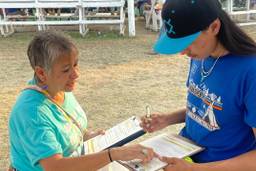The Farmers Who Can’t Afford Farms
Thirty-eight percent of young farmers—including 62% of young Black farmers—have student debt, which can make it impossible to take on farm loans.
Joseph Bullington

Running a small farm is complicated enough. For Tessa Parks — who raises cattle and hay with her spouse, Wyatt, on the gentle, farmed-over hills outside Northfield, Minn. — the challenges include bottle-feeding calves, braving bad weather to check on the herd at pasture and dealing with customers at the farmers market. Climate change doesn’t make it easier, as it lends intensity to droughts and storms and increases livestock disease risks.
But for Parks, a 28-year-old beginning farmer, the complexities don’t end there. Farming, for her, also means juggling relationships with five different landowners the couple rents a patchwork of hayfields and pasture from. It means she and Wyatt often work full-time off-farm jobs to pay that rent and buy supplies. And it means a lot of time driving — between home and work and market and cobbled-together farm.
The reason, as Parks explained to the Senate’s agriculture committee at a recent hearing, is simple: “We cannot afford land of our own.” They weren’t born into farmland, they don’t have a truckload of cash, and they struggle to access the kind of credit that could help them make the leap to farm ownership.
They aren’t the only young farmers who face this struggle, and that could spell trouble for farming as a whole. U.S. farmers are an aging bunch: More than 40 percent of them are over 65. As they retire in the coming years, the National Young Farmers Coalition predicts nearly half of U.S. farmland will change hands. Problem is, many of the would-be next generation of farmers cannot actually afford to buy it. Land prices are soaring, and many beginning farmers are unable or unwilling to take on the kind of loans they would need to buy farmland of their own. Unchecked, this means more farmland will likely be concentrated into ever more massive farms or be taken out of farming altogether.
Such a transition could accelerate the decades-long trend of land consolidation that has depopulated and economically depressed much of rural America. It could perpetuate or worsen the concentration of land in the hands of white landowners, who already own 98 percent of farmland. It could mean a lot of farmland and wildlife habitat gets lost beneath warehouses, CAFOs (large factory farms) and suburban housing developments. And it could mean a lot of beginning farmers either never escape tenancy or quit farming before they really get started.
A 2022 survey by the farmers coalition found that more than two-thirds of respondents who had stopped farming had done so in part because of lack of land access. Access to land and capital ranked as the top challenges for young farmers, with 59 percent reporting it “very or extremely challenging” to find affordable land. Statistically, the challenge is even greater for farmers like Parks, who is of Japanese-Filipino heritage: The survey found that 65 percent of Black and brown farmers struggled to access farmland.
That’s in part because these young farmers must compete for land with deep-pocketed corporations, private equity firms, real estate developers and second-home buyers. The coronavirus pandemic helped provoke a rush on rural land that has pushed up land prices across the country. The average price of farmland has surged 29 percent since 2020, according to the U.S. Department of Agriculture (USDA).
“The [farmland] transition is going to happen — the question is: to who?” says Vanessa García Polanco, government relations director for National Young Farmers Coalition. “My generation is eager to work the land, to farm, to feed our communities, to fight climate change.” But, García Polanco warns, if we don’t find ways to get farmland into their hands, “it’s going to transition to corporations, to big farms, to nonfarm owners.”
Numbers from the USDA’s most recent Census of Agriculture, released in February, bear out García Polanco’s warning. Between 2017 and 2022, 20 million acres of farmland were taken out of cultivation, and the number of farms fell by 142,000. Tellingly, the only class of farm that grew in number during that period was very large farms of more than 5,000 acres.
As farmland prices pull ever farther out of reach of young farmers, García Polanco says the USDA’s Farm Service Agency, which administers federal farm loan programs, is failing to help beginning farmers bridge the gap to farm ownership. Farm Service Agency loans too often hinge on paperwork and experience requirements that are hard for beginning farmers to meet, she says. And then there’s the obstacle of pre-existing debt: According to the farmers coalition’s 2022 survey, 38 percent of young farmers — and 62 percent of Black young farmers — have student loan debt, which can make them hesitant or ineligible to take on farm loans. And 20 percent of young farmers reported not taking out loans for their farm because of existing student loan debt.
More loans and more debt aren’t the answer for many young farmers, which is why the farmers coalition is advocating to pass the Increasing Land Access, Security and Opportunities Act. The bill would make permanent a USDA pilot program that offers an alternative to lending by granting money to community-based projects working to increase land access for underserved and beginning farmers.
Such community-based solutions to land access might look different from traditional lending and land ownership. For example, Sharing Our Roots Farm, where Tessa and Wyatt Parks pasture their cattle outside Northfield, operates on a commons model, providing shared access to land. A national organization called Agrarian Trust aims to spread an agrarian commons model across the country, opening up land access for landless farmers and permanently removing farmland from the commodity market. García Polanco says these community-led solutions could also look like groups using grant money to offer lower barrier loans or buy communally shared farm equipment.
“The beauty is that it’s community-led and farmer-led, because land access challenges look so different in every community,” García Polanco says.
Now, the farmers coalition is working to get the proposal included in the 2024 Farm Bill, which is currently making its way through both houses of Congress. But García Polanco worries legislators will try to put off funding young-farmer support programs until the next Farm Bill — five or so years away.
“By that time, how many more farms will we have lost?” García Polanco says. “It’s really scary what the next Census of Agriculture will say. We need to be aggressive in trying to keep farmers on the land.”
Joseph Bullington grew up in the Smith River watershed near White Sulphur Springs, Montana. He is the editor of Rural America In These Times.








